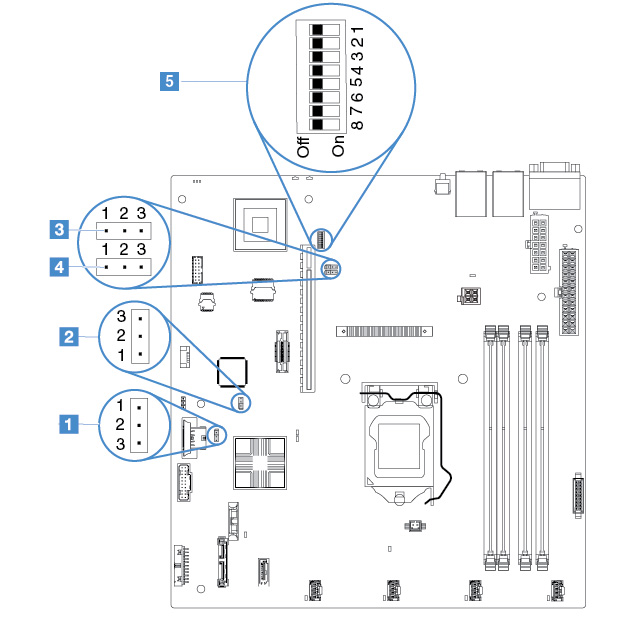System-board switches and jumpers
This topic helps you locate the jumpers and switches on the system board and get familiar with their functions.
Important
- Before you change any switch settings or move any jumpers, turn off the server. Then, disconnect all power cords and external cables. Review the information in Safety, Before removing or installing server components, and Turning off the server.
- Any system-board switch or jumper block that is not shown in the illustrations in this document are reserved.
- If there is a clear protective sticker on the switch blocks, you must remove and discard it to access the switches.
Figure 1. Switches and jumpers on the system board


| 1 Clear CMOS jumper | 2 UEFI boot backup jumper (JP24) |
| 3 TPM physical presence jumper (JP39) | 4 Share NIC jumper |
| 5 SW1 switch block |
The following table describes the jumpers on the system board.
| Jumper name | Description |
|---|---|
| Clear CMOS jumper |
|
| UEFI boot backup jumper |
|
| TPM physical presence jumper |
|
| Share NIC jumper |
|
If no jumper is present, the server responds as if the pins are set to the default.
Note
Changing the position of the UEFI boot backup jumper from pins 1 and 2 to pins 2 and 3 before the server is turned on alters which flash ROM page is loaded. Do not change the jumper pin position after the server is turned on. This can cause an unpredictable problem.
| Switch number | Default position | Description |
|---|---|---|
| 1, 3, 4, 5, 6, 7, 8 | Off | Reserved. |
| 2 | Off | Power-on password overrides. Changing the position of this switch bypasses the power-on password check the next time the server is turned on and starts the Setup Utility so that you can change or delete the power-on password. You do not have to move the switch back to the default position after the power-on password in overridden. Changing the position of this switch does not affect the administrator password check if an administrator password is set. See Passwords for additional information about passwords. |
Give feedback